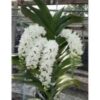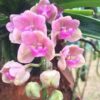# A Comprehensive Guide to Distinguishing Between Purebred and Hybrid Dendrobium Anosmum (Đai Châu Orchids)

The Dendrobium anosmum, popularly known as the Đai Châu orchid, is a celebrated species native to Southeast Asia, particularly Vietnam. Renowned for its stunning flowers and delightful fragrance, this orchid holds a special place in the hearts of enthusiasts and collectors. However, with the increasing popularity of this orchid, distinguishing between purebred and hybrid varieties has become essential for growers and enthusiasts alike. This guide will explore the key characteristics of purebred and hybrid Đai Châu orchids, their care requirements, and tips for identification.
## 1. Understanding the Basics
### 1.1 What is a Purebred Orchid?
A purebred orchid, also known as a true-to-type orchid, refers to a plant that has been cultivated and propagated from its natural, original species without any hybridization. In the case of Dendrobium anosmum, a purebred plant will exhibit the typical characteristics of the species as described in botanical classifications. These orchids are often valued for their authenticity and genetic stability.
### 1.2 What is a Hybrid Orchid?
Hybrid orchids, on the other hand, are created by cross-pollinating two or more different orchid species or varieties. This process results in a new plant that may exhibit traits from both parent plants. Hybrids can offer unique flower colors, shapes, and sizes, making them popular among collectors and growers who seek diverse and visually striking specimens.
## 2. Key Characteristics of Dendrobium Anosmum
To effectively distinguish between purebred and hybrid Dendrobium anosmum orchids, it is important to understand the defining characteristics of the species itself.
### 2.1 Flower Appearance
– **Purebred Dendrobium Anosmum**: The purebred form typically showcases clusters of fragrant flowers that are lavender to purple in color, often with a slight fragrance. The flowers usually measure 5-8 cm in diameter and have a waxy texture. The petals are narrow and elongated, with a slightly ruffled appearance.
– **Hybrid Dendrobium Anosmum**: Hybrid varieties may display a broader range of flower colors, including pink, white, and yellow, depending on the parent plants used in the crossbreeding. The size and shape of the flowers can also vary significantly. Some hybrids may produce larger blooms, while others might exhibit unique petal formations or patterns.
### 2.2 Plant Structure
– **Purebred Dendrobium Anosmum**: Purebred plants typically have a characteristic growth pattern with slender, cane-like pseudobulbs that can reach up to 60 cm in height. The leaves are narrow and lanceolate, growing in an alternating pattern along the stems.
– **Hybrid Dendrobium Anosmum**: Hybrid plants may show variations in growth habit, with some hybrids being more compact or bushy. The pseudobulbs may vary in thickness, height, and even coloration, influenced by the genetic traits of the parent species.
### 2.3 Growth Habits and Care Requirements
– **Purebred Dendrobium Anosmum**: This species thrives in bright, indirect light and prefers temperatures between 20-30°C. It requires a well-draining medium and regular watering during its active growth phase, while requiring a drier period during dormancy.
– **Hybrid Dendrobium Anosmum**: Hybrids can have different care requirements depending on their parentage. Some hybrids may adapt better to lower light conditions or require specific humidity levels. It is crucial to research the specific hybrid variety to provide the best care.
## 3. Identifying Purebred vs. Hybrid Dendrobium Anosmum
Now that we have established the basic characteristics of purebred and hybrid Dendrobium anosmum orchids, let’s delve into practical identification methods to distinguish between the two.
### 3.1 Examination of Flowers
One of the most straightforward ways to identify whether an orchid is a purebred or hybrid is through flower examination.
– **Color**: If the flowers are predominantly lavender or purple without any other colors, it is likely a purebred. If the flowers are a mix of colors or shades, it indicates a hybrid.
– **Size and Shape**: Measure the size of the blooms. Purebred Dendrobium anosmum flowers are usually smaller and narrower compared to some hybrids, which may exhibit larger, more varied shapes.
– **Fragrance**: Purebred Dendrobium anosmum is known for its delightful scent. If a flower lacks fragrance or has an entirely different scent profile, it may be a hybrid.
### 3.2 Observing Plant Structure
The growth structure of the plant can provide additional clues.
– **Height and Thickness**: Purebreds have consistent cane-like pseudobulbs, while hybrids may exhibit variations in height and thickness. Measure the pseudobulbs for consistency in size.
– **Leaf Shape**: The leaves of purebred Dendrobium anosmum are typically lanceolate. Hybrids may display a range of leaf shapes, including wider or rounder forms.
### 3.3 Consulting Labels and Documentation
When purchasing orchids from nurseries or stores, it is essential to check the labels or documentation provided.
– **Origin Information**: Purebred orchids are often labeled with their species name and may include details about their provenance.
– **Hybrid Designations**: Hybrid orchids will usually have a specific hybrid name, often consisting of the names of the parent plants. Familiarize yourself with common hybrid names to help with identification.
### 3.4 Understanding Growth Habits
Observe the growth habits and care needs of the plant.
– **Seasonal Behavior**: Purebred Dendrobium anosmum undergoes a pronounced dormancy period. If the plant does not show this behavior, it could indicate hybridization.
– **Environmental Preferences**: Compare your orchid’s growth and care preferences with the established norms for purebreds. Hybrids may exhibit varied responses to light, temperature, and humidity.
## 4. Care for Purebred and Hybrid Dendrobium Anosmum
### 4.1 Care for Purebred Dendrobium Anosmum
Caring for purebred Dendrobium anosmum requires adherence to specific guidelines to ensure optimal growth and flowering.
– **Light Requirements**: Provide bright, indirect light. Too much direct sunlight can scorch the leaves, while too little light may hinder flowering.
– **Watering**: Water thoroughly during the growing season, allowing the medium to dry slightly between waterings. Reduce watering during dormancy to prevent root rot.
– **Fertilization**: Use a balanced orchid fertilizer during the growing season to promote healthy growth and flowering.
– **Repotting**: Repot every couple of years or when the medium breaks down, ensuring a fresh growing environment for the roots.
### 4.2 Care for Hybrid Dendrobium Anosmum
Hybrid Dendrobium anosmum care will vary based on the specific hybrid. Here are some general tips:
– **Light Preferences**: Check for the specific light needs of your hybrid. Some may prefer bright light, while others might thrive in lower light conditions.
– **Watering and Humidity**: Monitor the watering needs based on the hybrid’s characteristics. Hybrids might require different humidity levels, so adjust your care routine accordingly.
– **Fertilization**: Similar to purebreds, use a balanced fertilizer, but pay attention to the hybrid’s growth stage and adapt feeding schedules.
– **Adaptation**: Be prepared to adjust care based on the plant’s response to your environment. Hybrids may demonstrate unique traits that require more attentive care.
## 5. The Importance of Knowledge in Orchid Cultivation
Understanding the differences between purebred and hybrid Dendrobium anosmum orchids is crucial for both novice and experienced growers. This knowledge can enhance your cultivation practices, helping you appreciate the unique beauty and traits of each variety.
### 5.1 Conservation of Purebred Species
Preserving purebred species like the Dendrobium anosmum is essential for maintaining genetic diversity within the orchid family. By cultivating purebreds, growers contribute to the conservation of natural species and their habitats.
### 5.2 Embracing Hybrid Diversity
At the same time, hybrid orchids allow for the exploration of new colors, forms, and fragrances. They provide an opportunity for growers to experiment with crossbreeding, contributing to the ongoing development of orchid varieties.
## 6. Conclusion
In conclusion, the Dendrobium anosmum, or Đai Châu orchid, is a stunning and cherished species that offers a wide array of possibilities for growers and enthusiasts. Understanding the differences between purebred and hybrid varieties is vital for successful cultivation and appreciation of this exquisite flower.
By examining flower characteristics, plant structure, care requirements, and consulting proper documentation, orchid enthusiasts can confidently distinguish between purebred and hybrid Dendrobium anosmum orchids. Whether you choose to cultivate a purebred for its authenticity or explore the vibrant world of hybrids, the beauty of the Đai Châu orchid will undoubtedly enrich your gardening experience.
As you embark on your orchid-growing journey, remember to embrace the unique stories and characteristics of each plant. With proper care and knowledge, you will nurture these extraordinary orchids, allowing their beauty to flourish in your home and garden.

